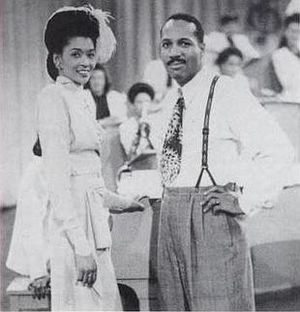William D. Alexander facts for kids
William D. Alexander (1916 – November 19, 1991) was an American filmmaker. He created special newsreels for African American audiences, supported by the U.S. government. Later, he started his own company, Alexander Productions, in New York City and became a film producer.
He made a short documentary called Village of Hope about a place in Liberia where people with leprosy lived. He also created the films Portrait of Ethiopia and Wealth of Wood. Wealth of Wood even won a United Nations Award at the Madrid International Film Festival in 1967.
Contents
Who Was William D. Alexander?
William D. Alexander was born in 1916, either in Denver, Colorado, or in Missouri. He grew up in Colorado and went to college at what is now the University of Northern Colorado and Chicago State University.
In 1941, Alexander moved to Washington, D.C. There, he worked for the National Youth Administration. He helped with a radio program. His job was to interview African Americans who worked for the U.S. government. He also created stories about the Black middle class in Washington.
Making Newsreels During World War II
During World War II, Alexander worked for the United States Office of War Information. He helped create newsreels and press releases. These shared news about African American soldiers and sailors. Alexander and his team made over 250 newsreels. These were released under the name All-American News.
Starting His Own Film Company
In 1945, Alexander moved to New York City. He started his own film company, Alexander Productions. He also founded the Associated Film Producers of Negro Motion Pictures.
Alexander produced many short musical films. Some famous ones include Jivin' in Bebop (which featured jazz legend Dizzy Gillespie), Burlesque in Harlem, and Open the Door, Richard. The theme from Open the Door, Richard later became a popular song.
He also produced longer films, known as features. These included The Fight Never Ends, where boxer Joe Louis played himself and fought against young people getting into trouble. Other films were The Highest Tradition and Rhythm in a Riff, which featured singer Billy Eckstine. Alexander's film Souls of Sin is known as the last "race movie" made by a Black producer. Race movies were films made for and often by African American audiences during a time of segregation.
Documentaries in Africa
In 1950, Alexander moved to London. For the next 18 years, he made many well-known documentaries. These films were about new countries in Africa that were gaining independence from colonial rule. Many African nations asked him to make these films. They used the documentaries to show the world what their new countries were like. Alexander even served as the official filmmaker for Liberia and Ethiopia at different times.
In 1960, the American ABC television network showed a twelve-part documentary series by Alexander. It was all about the new African states. The 22 African countries where Alexander worked gave him many awards for his films.
Award-Winning Films
One of Alexander's documentaries, The Village of Hope, was about a place in Liberia for people with leprosy. It won an award at the 1964 Cannes Film Festival. His film Portrait of Ethiopia won a prize at the 1965 Venice Film Festival. Another documentary, Wealth in Wood, received the United Nations Award at the Madrid International Film Festival in 1967.
Later Career and Challenges
In 1974, Alexander produced The Klansman. This film was based on a novel by William Bradford Huie. With a budget of $4.5 million, The Klansman was the biggest film Alexander ever made. It starred O. J. Simpson in his first acting role. The movie also featured famous actors like Richard Burton, Lola Falana, and Lee Marvin. Despite its large budget and famous cast, The Klansman was not very successful. His next film, Jackpot, stopped production and was never finished.
His Legacy
William D. Alexander passed away from cancer in the Bronx on November 19, 1991. In 1995, he was honored by being added to the Black Filmmakers Hall of Fame.
Filmography
- The Vanities (1946)
- The Highest Tradition (1946), about African American World War II war heroes
- Love in Syncopation (1946)
- Rhythm in a Riff (1947)
- The Fight Never Ends (1948)
- Souls of Sin (1949)
- Portrait of Ethiopia (1960)
- Village of Hope, a short documentary film about a leper colony in Liberia
- Wealth in Wood
- The Klansman (1974)
See also


